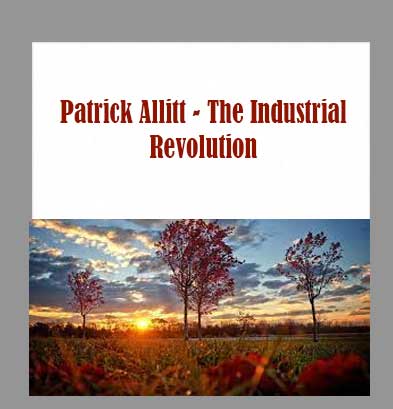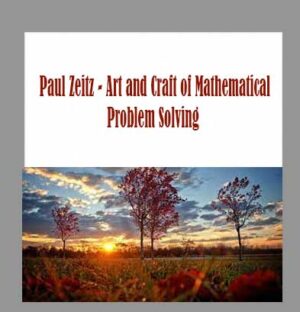Description
Patrick Allitt – The Industrial Revolution download, Patrick Allitt – The Industrial Revolution review, Patrick Allitt – The Industrial Revolution free
Patrick Allitt – The Industrial Revolution
The Industrial Revolution
Discover the inventors, business leaders, and ordinary workers who created our modern industrial world in a fascinating course taught by a top-rated professor.
LETURE (36)
01:Industrialization Is Good for You
Step into the story of one of the greatest periods in history. Although there is much to dislike about industrialization-including the loss of traditional ways of life, increased economic inequality, and environmental problems-we should nevertheless be grateful for the Industrial Revolution. Investigate why in this opening lecture.
02:Why Was Britain First?
Start at the beginning in the British Isles, where relative political stability, sophisticated financial institutions, colonial trade, a rising population of workers, and a class of scientists, thinkers, and entrepreneurs willing to experiment with innovation all contributed to the birth of the Industrial Revolution.
03:The Agricultural Revolution
In Britain in the 18th century, new agricultural methods came into being, freeing up thousands of workers to move into manufacturing work. Take a look at some of these changes to agriculture, including different uses of the land, the introduction of new crops, and the early mechanization of farming-all of which increased productivity.
04:Cities and Manufacturing Traditions
Traverse the country to see where industry took off, starting with a detailed look at the advantages and dangers of life in London. Then shift your attention to provincial cities and towns, where industrialists had to combat the guild system of labor, alcohol in the workplace, and workers who preferred the older, slower pace of life.
05:The Royal Shipyards
Explore the world of 18th-century shipyards, where the large-scale organization of work, materials, logistics, and complex construction would provide a blueprint for later factory-era industrialization. Find out how ships were made and what challenges shipbuilders faced-including fires, rot and decay, and logistical infrastructure.
06:The Textile Industry
Turn from the conditions that made the Industrial Revolution possible to the actual process of industrialization that began in the textile business. After surveying the work of spinning and weaving textiles, you learn about several key inventors and their innovations, including the flying shuttle, the spinning jenny, and the cotton gin.
07:Coal Mining-Powering the Revolution
Rising demand for coal and improvements in mining technology transformed coal mining into a large-scale capitalist enterprise. Dive into one of the most dangerous jobs in the world, see what problems miners had to overcome, and examine some of the solutions. Learn about steam engines, safety lamps, ventilation, and more.
08:Iron-Coking and Puddling
Along with coal, iron was one of the most important raw materials for the Industrial Revolution. After reviewing the history of iron, you study how to produce pig iron and forge wrought iron. Then you meet many of the key innovators who improved the process of bringing higher-quality iron into a growing market.
09:Wedgwood and the Pottery Business
Meet Josiah Wedgwood, whose pottery is among the most famous in the world. Thanks to his innovations in pottery-making technique and his division and “de-skilling†of labor in his factories, he turned his family’s cottage industry into an immense, lucrative manufacturing phenomenon.
10:Building Britain’s Canals
Transportation became critically important as new industries emerged. Find out how canal builders connected major cities by water, which greatly enhanced the country’s internal communications and allowed for the transportation of goods over long distances at relatively low cost. Look at the methods of building a canal and several key routes.
11:Steam Technology and the First Railways
The invention of the steam engine was a major turning point for industry. Meet the engineers and businessmen who developed and improved the engines and locomotives that would drive the British economy in the 19th century. Key figures include James Watt, Matthew Boulton, John “Iron-Mad†Wilkinson, and George Stephenson.
12:The Railway Revolution
See how British companies privately financed and built a national railroad system, and consider what it meant for the nation’s future. In addition to enabling faster communications, economic stimulus, and a boost to employment, the railroads affected the world of architecture, inspired the building of towns, and created a managerial class in the workforce.
13:Isambard Kingdom Brunel-Master Engineer
One of the great railway builders, Isambard Kingdom Brunel designed some of the nation’s most magnificent suspension bridges, as well as tunnel entrances and railway stations. Witness him then turning his attention to the world of shipbuilding, where he pioneered the production of ocean-going steamships.
14:The Machine-Tool Makers
Where would the world’s machines be without the tools with which to build and service them? We seldom think of the humble nuts and bolts that hold our machines together, but someone had to create and standardize them. Find out about that process and reflect on the importance-and impact-of industrial tools and their makers.
15:The Worker’s-Eye View
Step away from the machines and consider the human side of the Industrial Revolution. This lecture shows you how ordinary laborers struggled for autonomy and how they were especially vulnerable to fluctuations in the business cycle. Grapple with the powerful moral objections to capitalism, which were articulated most famously by Karl Marx and Friedrich Engels.
16:Poets, Novelists, and Factories
Survey a wealth of 19th-century British literature, from poets such as William Wordsworth to novelists such as Charles Dickens and Elizabeth Gaskell. These works of literature offer a unique perspective on the Industrial Revolution, from evocative descriptions of the new technology to scathing indictments of the emerging labor system.
17:How Industry Changed Politics
As industrialists in the 18th and 19th centuries became wealthy, they were able to gain political power and influence national policy. Delve into the debates over free trade and the political regulation of industry. Then look at some of the era’s efforts at political reform and several notable acts of Parliament.
18:Dismal Science-The Economists
The effects of the Industrial Revolution can be felt in every realm-perhaps none so starkly as the field of economics. Adam Smith, Thomas Malthus, David Ricardo, and others analyzed the causes and effects of industrialization and put forth the theories of capitalism that still underlie economics today.
19:American Pioneers-Whitney and Lowell
Shift your attention from Britain to the United States, where a class of mobile and educated entrepreneurs stood poised to build an industrial economy. This lecture introduces you to the world of American manufacturing. Learn about Francis Cabot Lowell and Eli Whitney, early innovators in the U.S. textile industry.
20:Steamboats and Factories in America
Continue your study of American industrialization with a look at the steamships, canals, and railways that opened up the great continent. Then turn to a series of great inventions in the 19th century, including the McCormick reaper, the John Deere steel plow, the telegraph, and the Colt revolver.
21:Why Europe Started Late
Great Britain may have started the revolution, but other nations soon followed-and they had the advantage of learning from Britain’s trials and errors. Reflect on why the rest of Europe lagged behind in the Industrial Revolution, and take a look at what efforts Belgium, France, and Germany took to catch up.
22:Bismarck, De Lesseps, and Eiffel
After the unification of Germany in 1871, the nation industrialized rapidly. Thanks to a sophisticated educational system that emphasized science, German industries excelled at manufacturing chemicals, electrical equipment, and more. After witnessing the rise in German output, turn to several key innovations in France.
23:John D. Rockefeller and Standard Oil
Learn the history of one of the most successful companies in American history. As oil became one of the world’s most lucrative industries, John D. Rockefeller seized opportunities and built a monopoly with Standard Oil. Consider his questionable business tactics and the antitrust regulation they inspired.
24:Andrew Carnegie and American Steel
Meet Andrew Carnegie, the American steel magnate who was a fanatic for business discipline, efficiency, record keeping, and technological modernization. See how he drove his competitors out of business as the demand for steel railways and bridges rose. Find out how he organized and diversified his business.
25:American Industrial Labor
The American belief in upward mobility and its heterogeneous workforce constrained the union labor movement. Nevertheless, many strikes and protests did occur in response to industrialization. Experience the Great Railroad Strike, the Haymarket Square riot, and other important events in the history of American labor.
26:Anglo-American Contrasts
Compare Britain and the United States in the 19th century to see what forces caused Britain to lose its competitive edge in the Industrial Revolution. While labor unions and fewer raw materials put Britain at a disadvantage, the real difference lay in each nation’s attitude toward work, leisure, and social class.
27:Electric Shocks and Surprises
We take electricity for granted today, but in the 19th century it was a sensation. Review the science behind electrical technology, from Ben Franklin and Alessandro Volta to Michael Faraday and Samuel Morse. Then learn about the rivalry between Thomas Edison’s direct current and George Westinghouse’s alternating current.
28:Mass-Producing Bicycles and Cars
Interchangeable parts and mass production took the Industrial Revolution to a new level. Beginning with the bicycle industry in the 1870s and continuing through the rise of automobiles in the 20th century, this lecture shows how mechanized transportation not only changed the world for consumers-it also transformed the business of factory labor.
29:Taking Flight-The Dream Becomes Reality
Experience the birth of aviation when two bicycle repairmen from Ohio took off from a beach near Kitty Hawk, North Carolina. Discover what experiments in flight preceded the Wright brothers-including lighter-than-air zeppelins-and look at the effect aviation had in the years leading up to World War I.
30:Industrial Warfare, 1914-1918
Despite its myriad benefits on our world today, industrialization is also responsible for some of the 20th-century’s most horrific carnage. Planes, tanks, and chemical weaponry have all played a role in global warfare. Meet the players of the First World War and explore the role played by the new military-industrial-political system.
31:Expansion and the Great Depression
Marxists fully expected the overthrow of capitalism in the United States or Great Britain. Why did that revolution never come to pass? Immerse yourself in the interwar years, when governments, managers, and workers alike grappled with the psychology of capitalism and the forces of creative destruction.
32:Mass Production Wins World War II
Reflect on how industry and technology contributed to the phenomenal destructiveness of World War II and helped the Allies win the war. With the Soviet Union’s mass-produced tanks and aircraft and U.S. and British bombers and special weaponry, the Allies were well prepared to defeat the industrially weakened Germans.
33:The Information Revolution
Unpack the history of computers, from early calculating machines and cash registers to transistors and integrated circuits. Professor Allitt shows you the political and economic effects of the information age. Who are the winners and losers in the information age? Have we entered a “post-industrial†society?
34:Asian Tigers-The New Industrialized Nations
Since World War II, Japan, China, and other Asian nations have emerged as industrial powerhouses. Follow Japan as it gradually built a reputation for making dependable, low-priced goods. Then shift your attention to China and see how it has achieved rapid economic growth in recent decades. Conclude with an examination of modern-day India.
35:Environmental Paradoxes
One key threat from industry is the negative effect on the environment. Examine how businesses and governments have responded to threats such as air and water pollution, oil spills, nuclear fallout, overpopulation, resource exhaustion, and climate change. Find out what solutions government regulation and the free market have to offer.
36:The Benign Transformation
Conclude your course with some final thoughts about the impact of the Industrial Revolution. Professor Allitt asks whether the revolution is over and if we will continue to benefit from new technological and societal advances. Take stock of everything you’ve learned and explore what the future may hold.
DETAILS
Overview
We owe so much of our world to the Industrial Revolution. The Great Courses partners with the Smithsonian to examine the extraordinary events and uncover the far-reaching impact of this incredible era. In 36 fascinating lectures, Professor Allitt introduces you to the inventors, businessmen, and workers responsible for transforming our lives and fueling one of the greatest periods of innovation in human history.
About
Patrick N. Allitt
Nostalgia is the enemy of history. ‘Downton Abbey’ is great fun but it’s not history. If seeing or reading something historical makes you feel warm and cosy, it’s probably very inaccurate.
ALMA MATER
University of California, Berkeley
INSTITUTION
Emory University
Dr. Patrick N. Allitt is Cahoon Family Professor of American History at Emory University, where he has taught since 1988. The holder of a doctorate in history from the University of California, Berkeley, Professor Allitt-an Oxford University graduate-has also taught American religious history at Harvard Divinity School, where he was a Henry Luce Postdoctoral Fellow. He was the Director of Emory College’s Center for Teaching and Curriculum from 2004 to 2009, where he looked for ways to improve teaching. In this critical administrative position, he led workshops on a wide variety of teaching-related problems, visited dozens of other professors’ classes, and provided one-on-one consultation to teachers to help them overcome particular pedagogical problems. Professor Allitt was honored with Emory’s Excellence in Teaching Award and in 2000 was appointed to the N.E.H./Arthur Blank Professorship of Teaching in the Humanities. A widely published and award-winning author, Professor Allitt has written several books, including The Conservatives: Ideas and Personalities throughout American History; Catholic Intellectuals and Conservative Politics in America, 1950-1985; Catholic Converts: British and American Intellectuals Turn to Rome; and Religion in America since 1945: A History. He is also author of I’m the Teacher, You’re the Student: A Semester in the University Classroom, a memoir about one semester in his life as a university professor. In addition, he is the editor of Major Problems in American Religious History. He has written numerous articles and reviews for academic and popular journals, including The New York Times Book Review.







